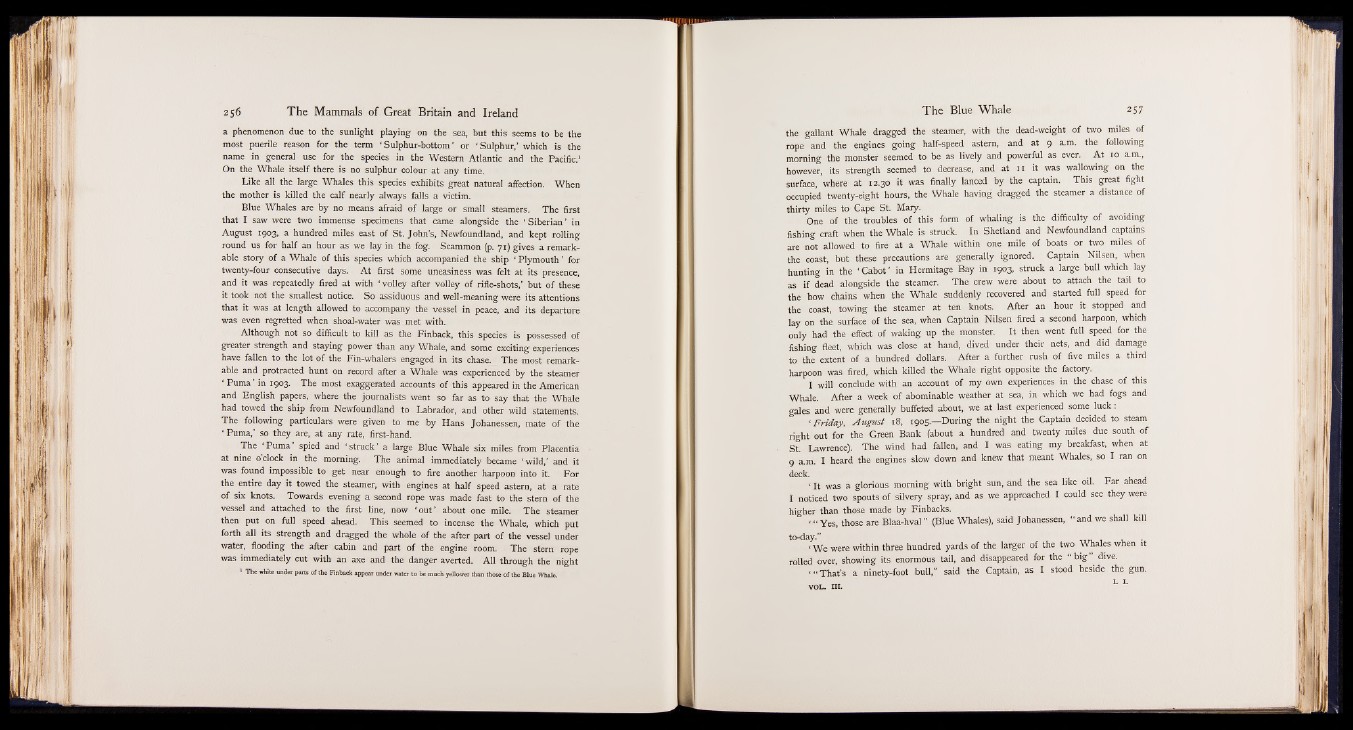
a phenomenon due to the sunlight playing on the sea, but this seems to be the
most puerile reason for the term ‘ Sulphur-bottom’ or ‘ Sulphur,’ which is the
name in general use for the species in the Western Atlantic and the Pacific.1
On the Whale itself there is no sulphur colour at any time.
Like all the large Whales this species exhibits great natural affection. When
the mother is killed the calf nearly always falls a victim.
Blue Whales are by no means afraid of large or small steamers. The first
that I saw were two immense specimens that came alongside the ‘ Siberian’ in
August 1903, a hundred miles east of St. John’s, Newfoundland, and kept rolling
round us for half an hour as we lay in the fog. Scammon (p. 71) gives a remarkable
story of a Whale of this species which accompanied the ship ‘ Plymouth ’ for
twenty-four consecutive days. At first some uneasiness was felt at its presence,
and it was repeatedly fired at with ‘ volley after volley of rifle-shots,’ but of these
it took not the smallest notice. So assiduous and well-meaning were its attentions
that it was at length allowed to accompany the vessel in peace, and its departure
was even regretted when shoal-water was met with.
Although not so difficult to kill as the Finback, this species is possessed of
greater strength and staying power than any Whale, and some exciting experiences
have fallen to the lot of the Fin-whalers engaged in its chase. The most remarkable
and protracted hunt on record after a Whale was experienced by the steamer
‘ Puma’ in 1903. The most exaggerated accounts of this appeared in the American
and English papers, where the journalists went so far as to say that the Whale
had towed the ship from Newfoundland to Labrador, and other wild statements.
The following particulars were given to me by Hans Johanessen, mate of the
* Puma,’ so they are, at any rate, first-hand.
The ‘ Puma spied and ‘ struck’ a large Blue Whale six miles from Placentia
at nine oclock in the morning. The animal immediately became ‘wild,’ and it
was found impossible to get near enough to fire another harpoon into it. For
the entire day it towed the steamer, with engines at half speed astern, at a rate
of six knots. Towards evening a second rope was made fast to the stern of the
vessel and attached to the first line, now ‘ out’ about one mile. The steamer
then put on full speed ahead. This seemed to incense the Whale, which put
forth all its strength and dragged the whole of the after part of the vessel under
water, flooding the after cabin and part of the engine room. The stern rope
was immediately cut with an axe and the danger averted. All through the night
1 The white under parts of the Finback appear under water to be much yellower than those of the Blue Whale.
the gallant Whale dragged the steamer, with the dead-weight of two miles of
rope and the engines going half-speed astern, and at 9 a.m. the following
morning the monster seemed to be as lively and powerful as ever. At 10 a.m.,
however, its strength seemed to decrease, and at 11 it was wallowing on the
surface, where at 12.30 it was finally lanced by the captain. This great fight
occupied twenty-eight hours, the Whale having dragged the steamer a distance of
thirty miles to Cape St. Mary.
One of the troubles of this form of , whaling is the difficulty of avoiding
fishing craft when the Whale is struck. In Shetland and Newfoundland captains
are not allowed to firé at a Whale within one mile of boats or two miles of
the coast, but these precautions are generally ignored. Captain Nilsen, when
hunting in the 'Cabot' in Hermitage Bay in 1903, struck a large bull which lay
as if dead alongside the steamer. The crew were about to attach the tail to
the bow chains when the Whale suddenly recovered and started full speed for
the coast, towing the steamer at ten knots: After an hour it stopped and
lay on thé surface of the sea, when Captain Nilsen fired a second harpoon, which
only had the effect of waking up the monster. It then went full speed for the
fishing fleet, which was close at hand, dived under their nets, and did damage
to the extent of a hundred dollars. After a further rush of five miles a third
harpoon was fired, which killed the Whale right opposite the factory.
I will conclude with an account of my own experiences in the chase of this
Whale. After a week of abominable weather at sea, in which we had fogs and
gales and were generally buffeted about, we at last experienced some luck:
1 Friday, August iS, 1905.— During the night the Captain decided to steam
right out for the Green Bank (about a hundred and twenty miles due south of
St. Lawrence). The wind had fallen, and I was eating my breakfast, when at
9 a.m. I heard the engines slow down and knew that meant Whales, so I ran on
‘ It was a glorious morning with bright sun, and the sea like oil. Far ahead
I noticed two spouts of silvery spray, and as we approached I could see they were
higher than those made by Finbacks,
' “ Yes, those are Blaa-hval ” (Blue Whales), said Johanessen, “ and we shall kill
to-day.”
‘ We were within three hundred yards of the larger of the two Whales when it
rolled over, showing its enormous tail, and disappeared for the “ big dive.
‘ “ That’s a ninety-foot bull,” said the Captain, as I stood beside the gun.
l L
VOL. III.